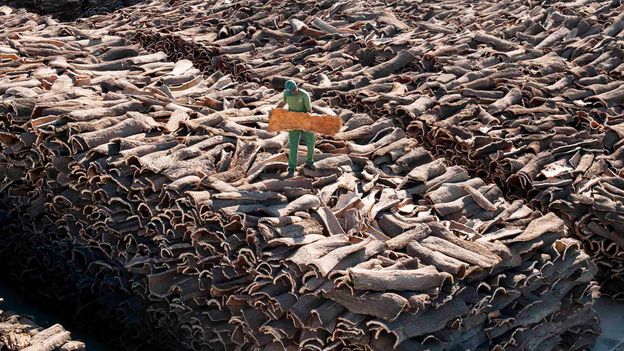Cork is now being used in electric cars to protect batteries from heat and vibration, and its heat absorbing properties have protected space rockets from the Space Shuttle programme to Nasa’s new Artemis spacecraft which has Portuguese cork in its nose cone. Waste cork dust is also burned as an alternative to fossil fuels to power some of the production lines.
Cork stoppers can also be collected, recycled, granulated and put to many of these different uses, with cork recycling programmes having been introduced across the world, including Recorked in the UK and ReCORK in the US.
Material scientists in Amorim’s iCork lab are also experimenting by combining cork with rubber and bio-based or biodegradable polymers to develop other new uses including injection moulding.
“It’s [got] the advantages of cork mixed with the advantages of plastic,” says Álvaro Batista, who is prototyping new materials to replace the foil top on wine bottles, to allow rolls of sheet cork and to be used for injection moulding. We receive a lot of materials from other industries…to mix with cork to improve the properties of cork and of course reusing raw materials…to help to solve sustainability problems,” he says.
The cork oak is Portugal’s national tree, protected since 1209, and cutting one down or even pruning it without permission can land you with a hefty fine.
Twenty years ago the symbiotic relationship between ecosystem and industry was threatened by the rise of plastic corks, aluminium screw caps and the dreaded cork taint. The problem now is having enough cork – demand is growing and the value of Portuguese exports reached an all-time high of €1.13bn (£921.29m/$1.09bn) in 2021.
The biggest threats to the trees are intense wildfires and drought which are increasingly a risk amid the extremes of climate change. The warming climate also changes the threat posed by disease from moths, beetles and weevils, which burrow into the bark carrying fungi and bacteria.
So while cork oaks could help to combat climate change, they are also at risk from it. Without incentives or a viable carbon market other threats from cattle farming and urban expansion could also cause the valuable montado landscape where the oaks grow to dwindle.
The Whistler itself is a sign of just what could be lost. The men wielding the axes left it untouched this year, but its next trim will be the tree’s 21st of its long life. They estimate this could surpass the tree’s own record-breaking 1991 yield of more than 1,200kgs of cork – enough for 100,000 stoppers. Locked inside them will be the carbon from nearly a decade of growth.
* Alastair Leithead is a former BBC foreign correspondent now attempting to live off the grid in Portugal on a 17 acres (seven hectares) plot of land that includes cork oaks, olive trees, pine and eucalyptus. He also writes a blog about wine in Portugal.
—
Join one million Future fans by liking us on Facebook, or follow us on Twitter or Instagram.
If you liked this story, sign up for the weekly bbc.com features newsletter, called “The Essential List” – a handpicked selection of stories from BBC Future, Culture, Worklife, Travel and Reel delivered to your inbox every Friday.


